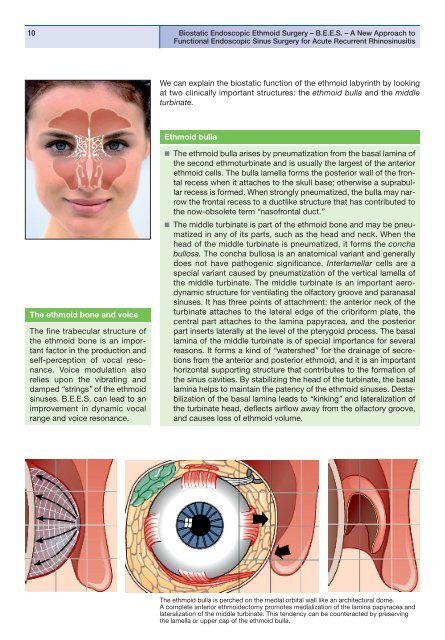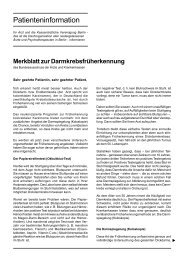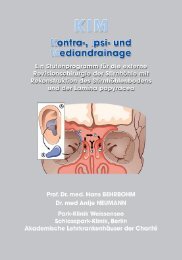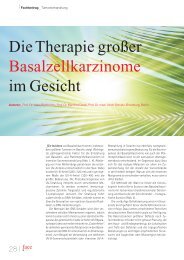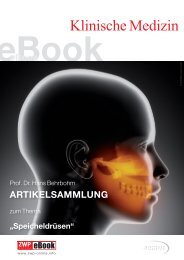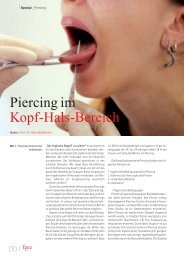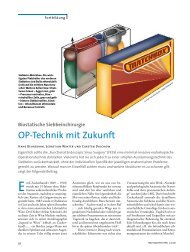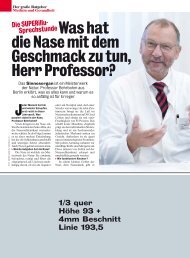BIOSTATIC ENDOSCOPIC ETHMOID SURGERY A New Approach ...
BIOSTATIC ENDOSCOPIC ETHMOID SURGERY A New Approach ...
BIOSTATIC ENDOSCOPIC ETHMOID SURGERY A New Approach ...
Create successful ePaper yourself
Turn your PDF publications into a flip-book with our unique Google optimized e-Paper software.
10<br />
Biostatic Endoscopic Ethmoid Surgery – B.E.E.S. – A <strong>New</strong> <strong>Approach</strong> to<br />
Functional Endoscopic Sinus Surgery for Acute Recurrent Rhinosinusitis<br />
We can explain the biostatic function of the ethmoid labyrinth by looking<br />
at two clinically important structures: the ethmoid bulla and the middle<br />
turbinate.<br />
Ethmoid bulla<br />
The ethmoid bone and voice<br />
The fine trabecular structure of<br />
the ethmoid bone is an important<br />
factor in the production and<br />
self-perception of vocal resonance.<br />
Voice modulation also<br />
relies upon the vibrating and<br />
damped “strings” of the ethmoid<br />
sinuses. B.E.E.S. can lead to an<br />
improvement in dynamic vocal<br />
range and voice resonance.<br />
The ethmoid bulla arises by pneumatization from the basal lamina of<br />
the second ethmoturbinate and is usually the largest of the anterior<br />
ethmoid cells. The bulla lamella forms the posterior wall of the frontal<br />
recess when it attaches to the skull base; otherwise a suprabullar<br />
recess is formed. When strongly pneumatized, the bulla may narrow<br />
the frontal recess to a ductlike structure that has contributed to<br />
the now-obsolete term “nasofrontal duct.”<br />
The middle turbinate is part of the ethmoid bone and may be pneuma<br />
tized in any of its parts, such as the head and neck. When the<br />
head of the middle turbinate is pneumatized, it forms the concha<br />
bullosa. The concha bullosa is an anatomical variant and generally<br />
does not have pathogenic significance. Interlamellar cells are a<br />
special variant caused by pneumatization of the vertical lamella of<br />
the middle turbinate. The middle turbinate is an important aero -<br />
dynamic structure for ventilating the olfactory groove and paranasal<br />
sinuses. It has three points of attachment: the anterior neck of the<br />
turbinate attaches to the lateral edge of the cribriform plate, the<br />
central part attaches to the lamina papyracea, and the posterior<br />
part inserts laterally at the level of the pterygoid process. The basal<br />
lamina of the middle turbinate is of special importance for several<br />
reasons. It forms a kind of “watershed” for the drainage of secre -<br />
tions from the anterior and posterior ethmoid, and it is an important<br />
horizontal supporting structure that contributes to the formation of<br />
the sinus cavities. By stabilizing the head of the turbinate, the basal<br />
lamina helps to maintain the patency of the ethmoid sinuses. Destabilization<br />
of the basal lamina leads to “kinking” and lateralization of<br />
the turbinate head, deflects airflow away from the olfactory groove,<br />
and causes loss of ethmoid volume.<br />
The ethmoid bulla is perched on the medial orbital wall like an architectural dome.<br />
A complete anterior ethmoidectomy promotes medialization of the lamina papyracea and<br />
lateralization of the middle turbinate. This tendency can be counteracted by preserving<br />
the lamella or upper cap of the ethmoid bulla.


